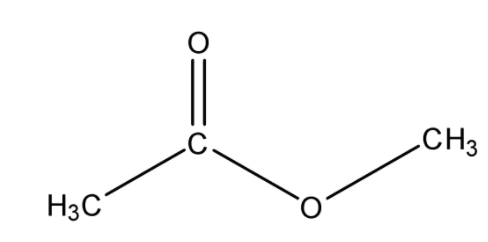
What functional group is in ethyl butyrate?
Answer
512.1k+ views
Hint : We know that we know that the ester is a chemical compound which is derived from an acid, in which an \[OH\] group is replaced by \[OR\]group. So, the structure of ether is\[RCOOR\]. Here, R represents the alkyl groups.
Complete Step By Step Answer:
Let’s discuss the naming of an ester. The naming of ester is done as if the alkyl chain from the alcohol is a substituent. Then, we do not need to assign numbers to the alkyl chain. Then, we have to name the parent chain from the carboxylic acid part of ester. Then, the ‘e’ of the parent should be replaced with ‘oate’. Then, the \[R\]group bonded to the \[O\]atom is named as substituent (prefix).
Ethyl butyrate is another name for ethyl butanoate. Some common names and their corresponding IUPAC equivalents are:
formate $=$ methanoate
acetate $=$ ethanoate
propionate $=$ propanoate
butyrate $=$ butanoate
valerate $=$ pentanoate
An alkanoate is a salt or ester derivative of a carboxylic acid group (such as sodium acetate/ethanoate), so ethyl butanoate is the ester derivative of butanoic acid. It forms from an esterification reaction of ethanol (ethyl alcohol) with butanoic acid on high heat in the presence of an acid catalyst (such as \[{{H}_{2}}S{{O}_{4}}\]) to remove the \[OH\] from the alcohol and the \[H\] from the carboxylic acid.

Note :
Remember that it is to be noted that when carboxylic acid undergoes reaction with alcohol in the presence of an acid catalyst, ester formation takes place. The acid catalyst that is commonly used in this reaction is concentrated sulphuric acid .
Complete Step By Step Answer:
Let’s discuss the naming of an ester. The naming of ester is done as if the alkyl chain from the alcohol is a substituent. Then, we do not need to assign numbers to the alkyl chain. Then, we have to name the parent chain from the carboxylic acid part of ester. Then, the ‘e’ of the parent should be replaced with ‘oate’. Then, the \[R\]group bonded to the \[O\]atom is named as substituent (prefix).
Ethyl butyrate is another name for ethyl butanoate. Some common names and their corresponding IUPAC equivalents are:
formate $=$ methanoate
acetate $=$ ethanoate
propionate $=$ propanoate
butyrate $=$ butanoate
valerate $=$ pentanoate
An alkanoate is a salt or ester derivative of a carboxylic acid group (such as sodium acetate/ethanoate), so ethyl butanoate is the ester derivative of butanoic acid. It forms from an esterification reaction of ethanol (ethyl alcohol) with butanoic acid on high heat in the presence of an acid catalyst (such as \[{{H}_{2}}S{{O}_{4}}\]) to remove the \[OH\] from the alcohol and the \[H\] from the carboxylic acid.

Note :
Remember that it is to be noted that when carboxylic acid undergoes reaction with alcohol in the presence of an acid catalyst, ester formation takes place. The acid catalyst that is commonly used in this reaction is concentrated sulphuric acid .
Recently Updated Pages
The angular momentum of a particle performing uniform class 11 physics CBSE

Study a part of the life cycle of the malarial parasite class 11 biology CBSE

If force F velocity V and time T are taken as fundamental class 11 physics CBSE

Atomic number of an atom is equal to the Anumber of class 11 chemistry CBSE

How do apocrine exocrine merocrine and holocrine glands class 11 biology CBSE

The block of mass M moving on the frictionless horizontal class 11 physics CBSE

Trending doubts
10 examples of friction in our daily life

One Metric ton is equal to kg A 10000 B 1000 C 100 class 11 physics CBSE

Difference Between Prokaryotic Cells and Eukaryotic Cells

1 Quintal is equal to a 110 kg b 10 kg c 100kg d 1000 class 11 physics CBSE

State the laws of reflection of light

Explain zero factorial class 11 maths CBSE




